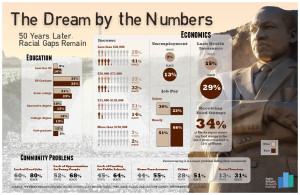It’s been nearly half a century since Dr. Martin Luther King Jr. shared his hope for a future in which the “manacles of segregation and the chains of discrimination” would no longer bind black  Americans, for a day when the United States would “rise up and live out the true meaning of its creed…that all men are created equal.”
Americans, for a day when the United States would “rise up and live out the true meaning of its creed…that all men are created equal.”
His speech, delivered from the steps of the Lincoln Memorial to hundreds of thousands of Americans who’d gathered in 1963 to participate in the March on Washington, did more than deliver the civil rights movement its most memorable moment. He articulated a vision that wove the aspirations of black Americans into the shared American dream.
The question remains, how much progress has been made during the past five decades? PRRI’s latest Graphic of the Week highlights the sharp racial divide in the economic fortunes of white and black America. Black Americans report many more problems facing their communities than do whites. Nearly seven-in-ten (68 percent) black Americans say lack of opportunities for young people is a major problem in their community while 52 percent of whites say the same. A majority of black Americans (51 percent) say that crime is a major problem in their community, compared to 28 percent of white Americans. While both white and black Americans say the lack of jobs is a major problem in their community, the degree of concern varies significantly between black (80 percent) and white Americans (60 percent). Finally, blacks are also more likely than whites to report that lack of funding for public schools is a major issue in their community (64 percent vs. 45 percent).
Today, religious leaders like King are continuing to address the issue of race in America – 48 percent of black Americans who attend church regularly (at least once per month) say their clergy sometimes or often speaks about discrimination and racism.